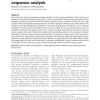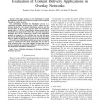144 search results - page 25 / 29 » A descriptive study of Microsoft's threat modeling technique |
BIB
2006
13 years 7 months ago
2006
One of the major goals of computational sequence analysis is to find sequence similarities, which could serve as evidence of structural and functional conservation, as well as of ...
TPDS
2008
13 years 7 months ago
2008
This paper proposes a new methodology to model the distribution of finite size content to a group of users connected through an overlay network. Our methodology describes the distr...
SIGSOFT
2007
ACM
14 years 8 months ago
2007
ACM
Model checking techniques have traditionally dealt with temporal logic languages and automata interpreted over -words, i.e., infinite in the future but finite in the past. However...
ADC
2009
Springer
14 years 2 months ago
2009
Springer
Access control has been studied for sometime, and there are a number of theories and techniques for handling access control for single or centralised systems; however, unique and ...
EDBT
2009
ACM
14 years 2 months ago
2009
ACM
To our best knowledge, all existing graph pattern mining algorithms can only mine either closed, maximal or the complete set of frequent subgraphs instead of graph generators whic...



